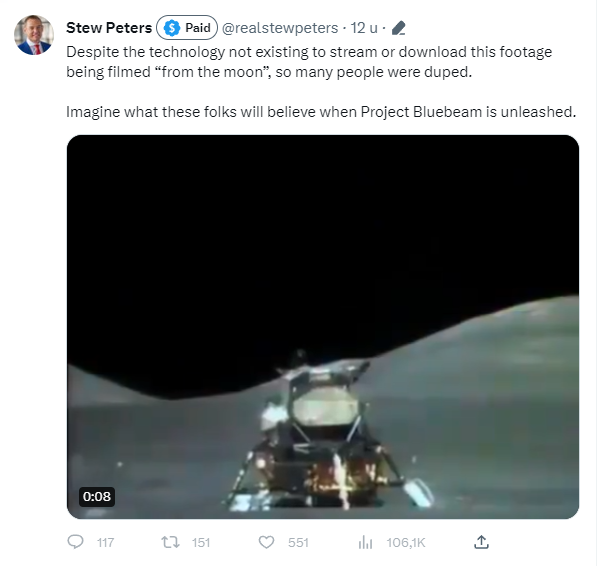STORY UPDATED: check for updates below.

Is livestreamed footage of the lunar module Challenger's 1972 takeoff from the moon fake since the technology did not exist at the time to livestream such an event? No, that's not true: NASA's chief historian confirmed to Lead Stories that the "footage is authentic to the Apollo 17 mission." As part of the Apollo missions of the 1960s and 1970s, NASA commissioned electronics manufacturers Westinghouse and RCA to design lightweight TV cameras capable of recording in space and livestreaming the broadcast to Earth. The video in question was captured on December 14, 1972, and showed the Apollo 17 lunar module Challenger ascending from the surface of the moon in real time.
The claim that the footage is not legitimate appeared in a post shared on Twitter on June 14, 2023, (archived here) by Stew Peters, who is defined by the Anti-Defamation League as a "far-right conspiracy theorist." The post featured authentic footage filmed from the moon and read:
Despite the technology not existing to stream or download this footage being filmed 'from the moon', so many people were duped.
Imagine what these folks will believe when Project Bluebeam is unleashed.
Here is how the post appeared at the time of writing:
(Source: Twitter screenshot Thu June 15 03:47:00 UTC 2023)
The above post implied that missions to the moon were faked. Peters did not provide any information about the origins of the footage he posted, where it was taken or what it depicted.
Lead Stories determined that the video shared in the Twitter post is authentic footage of the Apollo 17 lunar module Challenger, filmed on December 14, 1972, as it was ascending from the surface of the moon. At the time, the takeoff was livestreamed to Earth for viewers to watch.
NASA Chief Historian Brian Odom confirmed to Lead Stories that the "footage is authentic to the Apollo 17 mission."
"It was captured by the Lunar Roving vehicle camera system, operated remotely from mission control with footage beamed back to Earth," Odom told Lead Stories in an email received on June 16, 2023.
Jordan Penning of the British Royal Aeronautical Society also confirmed to Lead Stories that the technology to live stream from the moon did, indeed, "exist" at the time the video was recorded. In an email received June 19, 2023, Penning wrote:
The technology for streaming live events via satellite across the globe was demonstrated by the Early Bird satellite in 1965. That occurred four years after President [John F.] Kennedy's famous speech in which he said that the USA "should commit itself to achieving the goal, before this decade is out, of landing a man on the moon and returning him safely to the earth." In that same speech, he also called for funding to "accelerate the use of space satellites for world-wide communications" which led to the creation of the Early Bird satellite programme...
This technology was then used to disseminate live TV of the 1968 Olympic Games in Mexico to the world before being used to relay Neil Armstrong stepping onto the Moon's surface in July 1969.
Astronauts Gene Cernan and Harrison Schmitt participated in the 1972 Apollo 17 mission and also helped record the footage, which is now archived by NASA. The space agency described the event:
The television camera was mounted on the rover which Gene parked about 145 meters east of (behind) the lunar module. The ascent stage ignites and climbs, spacecraft foil and dust flying in all directions. Ed Fendell in Houston anticipates exactly the timing of ignition, lift-off, and the rate of climb, and the camera tilts to follows the ascent. At pitchover, the throat of the ascent engine points down at the camera and its combustion is visible as a small bright light. The clip ends as Challenger reaches an altitude of 1,500 feet.
A freeze-frame of the footage is below:
(Source: NASA)
The Apollo program, which ran from 1968 until 1972, included six moon landings, NASA reports.
A 2011 article from The Smithsonian Institution's Air and Space Museum, which contains one of the world's largest collection of space artifacts, documented NASA's preparations to film these missions. Rather than use the large, bulky cameras of the day, the agency contracted electronic manufacturers Westinghouse and RCA to build small, portable cameras. NASA engineers then calculated how to film the lunar liftoff through a series of trials, the article elaborates:
Attached to a pan and tilt unit, the television camera could be controlled directly from Earth via a large high-gain antenna on the rover. Since signals to and from Earth are delayed by a few seconds due to the 240,000 mile distance, mission engineers suggested pre-programming the lunar module liftoffs for Apollo missions 15, 16, and 17. Based on mathematical calculations, the rover would be driven and left some distance from lunar module, and the camera would automatically tilt up to show the ascent when commanded by the operator on Earth.
RCA designed the color camera like the one shown below, which was used in training endeavors. It is currently on display at the Smithsonian Institution's Human Spaceflight at the Steven F. Udvar-Hazy Center in Virginia.
(Source: Air and Space Museum)
The Air and Space Museum described how Apollo 15, 16 and 17 astronauts used these cameras, kept in the lunar module's equipment area, to broadcast their missions:
Mission commanders unpacked the cameras and put them on tripods to record early lunar activities such as unloading the rovers from the LM. Once attached to the lunar rovers, these television cameras could transmit footage directly to Earth via the Lunar Communications Relay Unit (an antenna) and using the power sources aboard the rovers. Researchers and scientists back on Earth could even remotely-control the television cameras to examine the lunar surface for themselves and track the astronauts as they explored areas around where they stopped the rovers.
On July 20, 1969, NASA used television and a communications satellite to broadcast over 238,000 miles -- from the moon to Earth -- the first manned mission to land on the moon.
Lead Stories also has reported that a phone call during the 1969 moon landing was not faked, that a "deathbed confession" video does not mean the U.S. government feigned the moon landing and that a video that shows a stage-lighting support hitting a supposed Apollo 11 astronaut does not prove that the Apollo 11 moon landing was a sham.
Updates:
-
2023-06-19T16:41:45Z 2023-06-19T16:41:45Z Adds confirmation from Royal Aeronautical Society spokesman that live-streaming technology did exist at the time of the Apollo 17 mission.


















